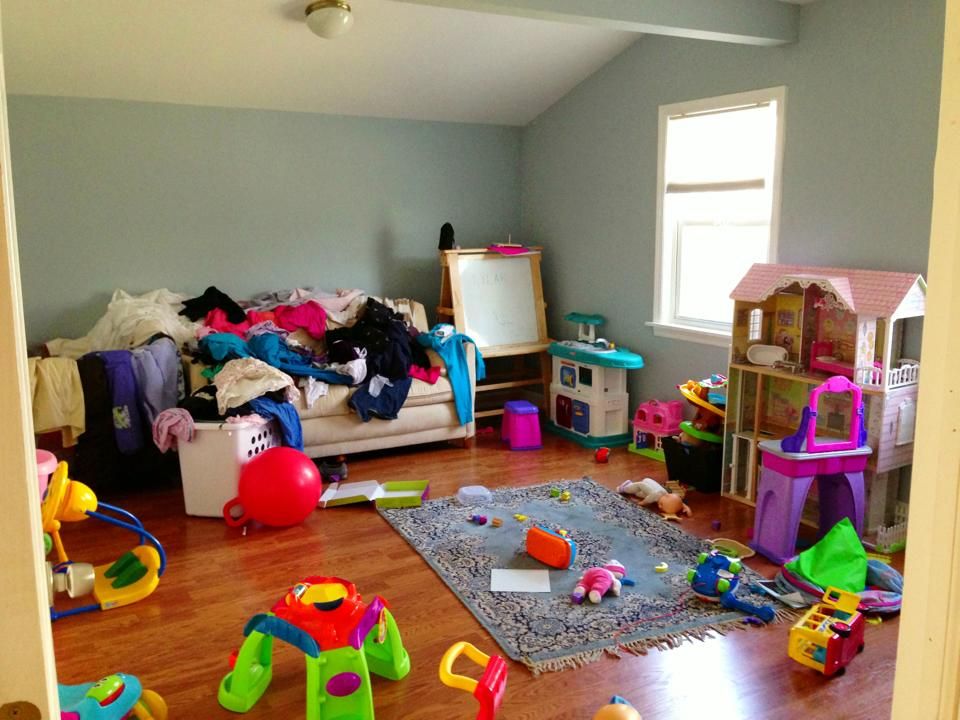
Is This Your Playroom?
Last year, I got a call from Dawn, who said in a frantic voice: “Eileen, I need your help, I must get my child’s playroom in order. I’m expecting in 3 months and I cannot live with the condition of this room any longer.” I could certainly understand her frustration, but there is more here than just the wave of the magic wand and organizational heaven. Her daughter, not quite four could not possibly be expected to keep her room in order when neither Mom nor Dad had a system set up to keep it well organized.
My first question to Dawn was, “What does Anne love to play with? Dawn’s answer gave me an idea of the real issues going on. “Oh, Anne loves EVERYTHING!” My first lesson to clients is that if EVERYTHING is important, then NOTHING is important. Getting Dawn to prioritize Anne’s play likes and dislikes should only take her a few minutes of observation. Drowning in a room filled with stuff sends the opposite message to what we should be teaching our children.
In a world where “more” is better, we soon learn that when it comes to children’s toys, the opposite is true. Teaching children as young as two the value of purging can help to SIMPLIFY their surroundings. Getting the family together each week to teach a child how to acquire the urge to purge can be a new and fun family activity. There are many lessons they can learn from this one activity.
1. They will learn that there is limited amount of items that can go in an area.
2. They are responsible for the care of their toys.
3. They can bless others with something they are no longer using.
Here’s how to simplify their spaces
TOYS AND CLOTHING
Most children today have many more toys than they need. They get over-stimulated, and often stop playing with them. Help your children as you edit their toys, by getting them to identify those they don’t like or are no longer interested in.
SKIP THE TOY BOX
Toy boxes are a guaranteed way for kids not to play with all their toys. They become a dumping ground, usually full of broken bits and lost pieces; and children won’t hesitate to dump everything out to find what they want. Instead, build shelves and invest in bins. (Clear is always a great way to go) Just make sure the shelves are low enough for younger children to reach.
BIG PURGE
Set aside one hour at a time to purge outgrown toys and clothes. Listen to your children and let them tell you what to give away. Don’t stop them from giving something away just because it is a gift or expensive toy, no matter where it came from or how much it cost. If the child doesn’t play with a toy or won’t wear a certain item, then it is clutter. If the unwanted item is a keepsake, then as a family create a keepsake bin and keep it in a special place. Honor and respect what is in your home.
CONTINUOUS CLEANING OUT
Create a give-away box. Decide how full the bin needs to be before you donate these items. Come up with a list of places looking for used items, and give your child a say in where they will go. Review which toys are still favorites and say bye-bye to toys that have lost their appeal.
HOMELESS ITEMS
Every few weeks, collect homeless pieces and get those odds-and-ends pieces together again.
ROTATE TOYS.
Remember the old 80/20 rule? Kids play 80% of the time with only 20% of their toys. Children are just like us…they love to play the same games over and over and over again. To make toys and books seem new again, store some away. A few months later, rotate the ones from storage. Just remember to mark your calendar.
LABEL WITH PICTURES
Labeling storage containers is always a good idea, but what if your kids are too young to read? Use clip art to include a picture with the word. You can print the labels on address label stickers or on plain paper that you stick to the container using clear packing tape. Or ask your organizer to recommend specialty pre-made labels.
ARTWORK
Everything your child draws and creates may seem like a masterpiece; but if you save it all, your child will never learn how to value what’s important. Designate a holding bin for the creations your little artist makes. Four times a year, especially over winter and summer breaks, go through them together and pick out 5 to 10 items to save for the future. Be sure your child includes some of his or her favorites, even if they’re not yours. Move the chosen items to a portfolio or keeper bin. Or get even simpler: take a digital picture or scan all of the artwork and save it on compact disc. Then choose one special art project, have it framed or shadowboxed, and display it in the child’s room or in your family room for EVERYONE to see. This not only creates personality in a room, it lets the artist know their work is valued.
A SEASONAL CLEAN-OUT
Purge children’s closets every 3 to 6 months. They grow out clothing faster than the blink of an eye.
PREVENTING THE PILES IN THE FIRST PLACE
When the time comes that people ask you for ideas what to give your kids, suggest gifts like memberships to the zoo or museum, tickets to a show, books and music, contributions to a college fund, donation to charity, etc. Older children will particularly enjoy movie passes and gift cards. Give with meaning and intention, not just easy and fast.
When a room is organized from a child’s perspective, they will soon love both the play and the organizing. And you’ll soon see: it’s possible to do both!
My first question to Dawn was, “What does Anne love to play with? Dawn’s answer gave me an idea of the real issues going on. “Oh, Anne loves EVERYTHING!” My first lesson to clients is that if EVERYTHING is important, then NOTHING is important. Getting Dawn to prioritize Anne’s play likes and dislikes should only take her a few minutes of observation. Drowning in a room filled with stuff sends the opposite message to what we should be teaching our children.
In a world where “more” is better, we soon learn that when it comes to children’s toys, the opposite is true. Teaching children as young as two the value of purging can help to SIMPLIFY their surroundings. Getting the family together each week to teach a child how to acquire the urge to purge can be a new and fun family activity. There are many lessons they can learn from this one activity.
1. They will learn that there is limited amount of items that can go in an area.
2. They are responsible for the care of their toys.
3. They can bless others with something they are no longer using.
Here’s how to simplify their spaces
TOYS AND CLOTHING
Most children today have many more toys than they need. They get over-stimulated, and often stop playing with them. Help your children as you edit their toys, by getting them to identify those they don’t like or are no longer interested in.
SKIP THE TOY BOX
Toy boxes are a guaranteed way for kids not to play with all their toys. They become a dumping ground, usually full of broken bits and lost pieces; and children won’t hesitate to dump everything out to find what they want. Instead, build shelves and invest in bins. (Clear is always a great way to go) Just make sure the shelves are low enough for younger children to reach.
BIG PURGE
Set aside one hour at a time to purge outgrown toys and clothes. Listen to your children and let them tell you what to give away. Don’t stop them from giving something away just because it is a gift or expensive toy, no matter where it came from or how much it cost. If the child doesn’t play with a toy or won’t wear a certain item, then it is clutter. If the unwanted item is a keepsake, then as a family create a keepsake bin and keep it in a special place. Honor and respect what is in your home.
CONTINUOUS CLEANING OUT
Create a give-away box. Decide how full the bin needs to be before you donate these items. Come up with a list of places looking for used items, and give your child a say in where they will go. Review which toys are still favorites and say bye-bye to toys that have lost their appeal.
HOMELESS ITEMS
Every few weeks, collect homeless pieces and get those odds-and-ends pieces together again.
ROTATE TOYS.
Remember the old 80/20 rule? Kids play 80% of the time with only 20% of their toys. Children are just like us…they love to play the same games over and over and over again. To make toys and books seem new again, store some away. A few months later, rotate the ones from storage. Just remember to mark your calendar.
LABEL WITH PICTURES
Labeling storage containers is always a good idea, but what if your kids are too young to read? Use clip art to include a picture with the word. You can print the labels on address label stickers or on plain paper that you stick to the container using clear packing tape. Or ask your organizer to recommend specialty pre-made labels.
ARTWORK
Everything your child draws and creates may seem like a masterpiece; but if you save it all, your child will never learn how to value what’s important. Designate a holding bin for the creations your little artist makes. Four times a year, especially over winter and summer breaks, go through them together and pick out 5 to 10 items to save for the future. Be sure your child includes some of his or her favorites, even if they’re not yours. Move the chosen items to a portfolio or keeper bin. Or get even simpler: take a digital picture or scan all of the artwork and save it on compact disc. Then choose one special art project, have it framed or shadowboxed, and display it in the child’s room or in your family room for EVERYONE to see. This not only creates personality in a room, it lets the artist know their work is valued.
A SEASONAL CLEAN-OUT
Purge children’s closets every 3 to 6 months. They grow out clothing faster than the blink of an eye.
PREVENTING THE PILES IN THE FIRST PLACE
When the time comes that people ask you for ideas what to give your kids, suggest gifts like memberships to the zoo or museum, tickets to a show, books and music, contributions to a college fund, donation to charity, etc. Older children will particularly enjoy movie passes and gift cards. Give with meaning and intention, not just easy and fast.
When a room is organized from a child’s perspective, they will soon love both the play and the organizing. And you’ll soon see: it’s possible to do both!
Eileen Koff CPO
www.tothenextlevel.net
631-553-0068
Give yourself the gift of order
Eileen Koff CPO, Professional Organizer of To The Next Level, specializes in family and home organizing on Long Island, NY. Her company was mentioned in Parent’s Magazine on the care of children’s rooms.
Previous Articles By Eileen:


